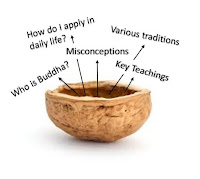Buddhism in a Nutshell first appeared in 1933. Since then several editions were published by various philanthropists for free distribution.
For a fuller exposition of the subjects dealt with here, readers may be interested in reading the revised and enlarged edition of The Buddha and His Teachings published in 1980.
— Narada, Vajirarama, Colombo, Sri Lanka, May 7th, 1982.
Namo Tassa Bhagavato Arahato
Samma-Sambuddhassa
Samma-Sambuddhassa
Chapter I: The Buddha
 On the full moon day of May, in the year 623 B.C.E., there was born in
the district of [the northwest frontier territories] a Sakyian [Scythian] prince named Siddhattha Gotama [Sanskrit, Siddhartha Gautama],
who was destined to be the greatest [spiritual] teacher in the world.
Brought up in the lap of luxury, receiving an education befitting a
prince, he married and had a son.
On the full moon day of May, in the year 623 B.C.E., there was born in
the district of [the northwest frontier territories] a Sakyian [Scythian] prince named Siddhattha Gotama [Sanskrit, Siddhartha Gautama],
who was destined to be the greatest [spiritual] teacher in the world.
Brought up in the lap of luxury, receiving an education befitting a
prince, he married and had a son.
His contemplative nature and boundless compassion did not permit him
to enjoy the fleeting material pleasures of a royal household. He knew
no woe, but he felt a deep pity for sorrowing humanity. Amid comfort
and prosperity, he realized the universality of sorrow [dukkha, disappointment].
The palace, with
all its worldly amusements, was no longer a congenial place for the
compassionate prince. The time was ripe for him to depart. Realizing the
vanity of sensual enjoyments, in his 29th year, he renounced
all worldly pleasures and donning the simple yellow garb of an ascetic,
alone, penniless, wandered forth in search of Truth and peace.
It was an unprecedented historic renunciation; for he renounced not
in his old age but in the prime of youth, not in poverty but in
plenty. As it was the belief in the ancient days that no deliverance
could be gained unless one leads a life of strict asceticism, he
strenuously practiced all forms of severe austerities. "Adding vigil
after vigil, and penance after penance," he made a superhuman effort for
six long years.
His body was reduced almost to a skeleton. The more he tormented his
body, the further his goal receded from him. The painful, unsuccessful
austerities which he strenuously practiced proved absolutely futile. He
was now fully convinced, through personal experience, of the utter
futility of self-mortification which weakened his body and resulted in
lassitude of spirit.
Benefiting by this invaluable experience of his, he finally decided
to follow an independent course, avoiding the two extremes of
self-indulgence and self-mortification. The former retards one's
spiritual progress, and the latter weakens one's intellect
The new way
which he himself discovered was the Middle Path, the Majjhima Patipada, which subsequently became one of the salient characteristics of his teaching.
One happy morning, while he was deeply absorbed in meditation [jhana, samadhi],
unaided and unguided by any supernatural power and solely relying on his
efforts and wisdom, he [cultivated the insight/wisdom that] eradicated all defilements, purified himself
and, realizing things as they truly are, attained enlightenment
(buddhahood) at the age of 35.
He was not born a buddha (an "awakened one"),
but he became one by his own striving. As the perfect embodiment
of all the virtues he preached, endowed with deep wisdom commensurate
with his boundless compassion, he devoted the remainder of his precious
life to serve humanity both by example and precept, dominated by no
personal motive whatever.
After a very successful teaching career of 45 long years, the Buddha, as
every other human being, succumbed to the inexorable law of change, and
finally passed away in his 80th year, exhorting his disciples to regard the liberating doctrine, Dharma, as their teacher.
The Buddha was a human being. As a man he was born, as a man he
lived, and as a super-human his life came to an end not in death, as with most, but reclining into final nirvana.
Though a human being, he
became an extraordinary man (acchariya manussa), but he never
arrogated to himself divinity. The Buddha laid stress on this important
point and left no room whatever for anyone to fall into the error of
thinking that he was an immortal divine being. Fortunately there is no
deification in the case of the Buddha. It should, however, be remarked
that there was no teacher "ever so godless as the Buddha, yet none so
god-like."
The Buddha is neither an incarnation of the Hindu God Vishnu, as is
believed by some, nor is He a savior who freely saves others by his
personal salvation. The Buddha exhorts his disciples to depend on
themselves for their deliverance, for both purity and defilement depend
on oneself.
Clarifying his relationship with his followers and
emphasizing the importance of self-reliance and individual striving, the
Buddha plainly states: "You should exert yourselves, the tathagatas (thus come ones/thus gone ones) are only teachers."
The buddhas point out the path, and it is left for us to follow that path to work out our own purification and final liberation.
"To depend on others for salvation is negative, but to depend on
oneself is positive." Dependence on others means a surrender of one's
effort.
In exhorting disciples to be self-dependent the Buddha says in the Parinirvana Sutra:
"Be ye islands [dipa, which also means lamps) unto yourselves, be ye a refuge unto yourselves, seek
not for refuge in others. [Seek it in the Dharma.]"
These significant words are self-elevating.
They reveal how vital is self-exertion to accomplish one's object and,
how superficial and futile it is to seek redemption through benignant
saviors and to crave for illusory happiness in an after life through the
propitiation of imaginary Gods or by irresponsive prayers and
meaningless [and often harmful] sacrifices. More






















































































































































































































































No comments:
Post a Comment